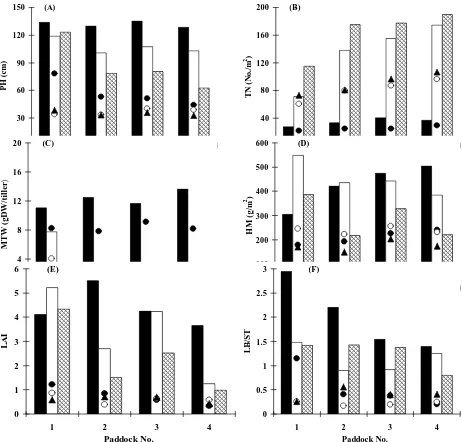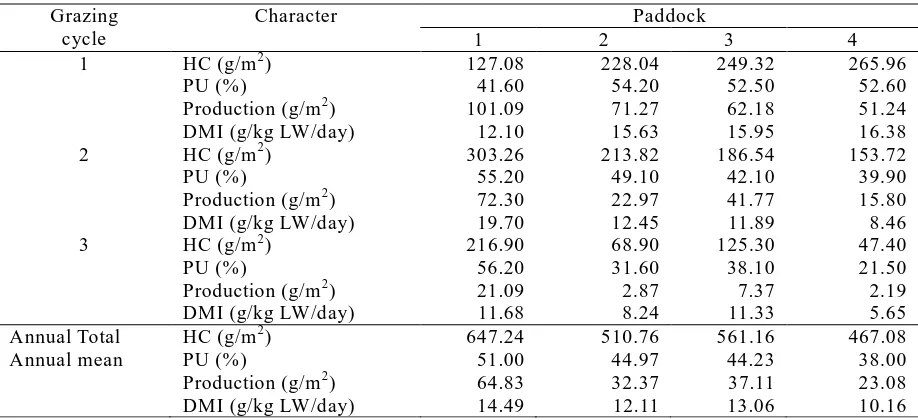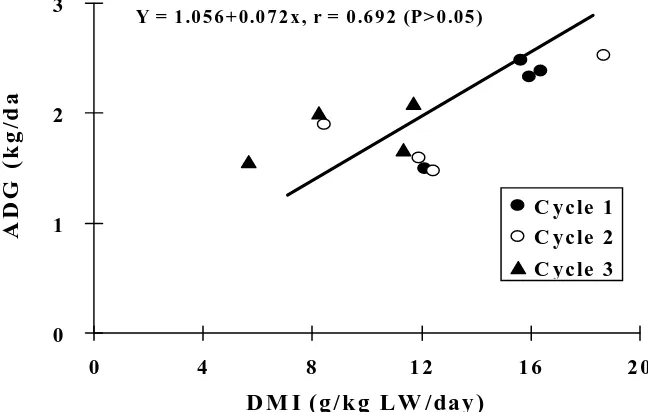ROTATIONAL GRAZING SYSTEM OF DWARF ELEPHANT GRASS
PASTURE BY BREEDING BEEF COWS AT THE FIRST YEAR
AFTER ESTABLISHMENT
M. Mukhtar1 and Y. Ishii2
1Faculty of Agriculture, Gorontalo State University, Kota Gorontalo 2Faculty of Agriculture, University of Miyazaki, Miyazaki-Japan
Received July 07, 2007, Accepted October 09, 2007
ABSTRACT
An intensive grazing in the dwarf-late (DL) elephant grass pasture in a rainy season was conducted under the rotational grazing system. Four paddocks of DL elephant grass pasture, which had a 5 (20 m × 25 m) of area/paddock, were grazed at 3 cycles of one-week grazing with 3-week rest period by 3 heads of breeding beef cows from May to November 2003. The plant height, leaf area index and ratio of leaf blade to stem were the highest, while tiller number increased and herbage mass tended to increase as grazing accured, except for the first grazing cycle. Herbage consumption, rate of herbage consumption and dry matter intake tended to decrease in three paddocks from the first to the third cycle. The average of dry matter intake was10.2-14.5 g DM/kg/LW/day over the four paddocks and the average daily gain was 0.09 kg/head day. The carrying capacities was estimated at 1016 (annual total 1224 CD/ha). Thus, DL elephant grass pasture can expand the grazing period for beef cows in a rainy season.
Keywords : Dwarf elephant grass, Herbage mass, Plant characters, Rotational grazing
INTRODUCTION
Rotational grazing is a method to enable an inten-sive grazing management which allows livestock to get a continuous opportunity to consume fresh mat-ter forage at an active growth (Chacon et al., 1990). Grazing system and associate management practices can substantially influence grazing patterns and utili-zation of a pasture. Pattern of selection and defolia-tion of herbage are probably the most important ef-fects of the grazing animal on the pasture such as leaf area reduction in the combination with carbohy-drate storage, tiller development, leaf and stem growth and herbage consumed (Sollenberger and Burns, 2001).
It is eagerly required by beef calf breeding farm-ers to obtain the self-supplying feed stably against the cattle disease probably caused by the imported herbages. From the previous study, dwarf elephant grass of late-heading type (dwarf-late, DL), introduced from Dairy Promotion Organization (DPO), Thailand, was able to overwinter in the lowland areas of Kyushu and had a higher percentage leaf blade (PLB) than other normal and dwarf varieties. DL was also the
most suitable for the grazing use among elephant grass varieties, because of the lower plant height with higher PLB than other varieties (Ishii et al., 1998).
In a preliminary study, we found that 0,05 ha of DL elephant grass pasture had the capacity to graze three beef cows for a week, with approximately a one-month rest period, without concentrated feeding in the hot summer season, in the 2 years following establishment (Mukhtar et al., 2004). However, to enhance our understanding of rotational grazing on DL elephant grass pasture, it is important to identify such variables as herbage consumption, carrying ca-pacity and sward management techniques to increase the live weight (LW) of beef cows, and to maintain the live weight (LW) of breeding beef cows. There have been several study reporting the high forage quality of dwarf elephant grass in Florida USA (Woodard and Prine, 1991; Sollenberger et al., 1993; Williams and Hanna, 1995), Georgia, USA (Hanna and Monson, 1988; Hanna et al., 1993), Taiwan (Hsu and Hong, 1993) and Thailand (Tudsri et al., 2002a, 2002b).
feed-ing cattle with concentrate or supplied roughage) to determine plant characters, herbage mass, herbage consumption and daily gain of breeding and raising beef cows on DL elephant grass pasture.
MATERIALS AND METHODS
Pasture management
The research was carried out in the Experimental Field, Miyazaki University, Japan during rainy season from May to November 2003. The examined variety of elephant grass (Pennisetum purpureum Schumach) was the dwarf-late (dwarf variety of late-heading type, DL) from Dairy Promotion Organization (DPO), Thai-land. The area of each paddock was 0.05 ha, and four paddocks were established rotational grazing by transplanting rooted tillers of elephant grass at about 20 cm in length. The elephant grass plants were sown at a density of two plants per m2, and space in a 1 m × 0.5 m pattern. Each paddock was fertilized with 20 g N/m2/year of chemical compound fertilizer (N:P2O5:K2O = 13%:13%;13%) applied in four split applications every year. Fertilization was conducted at pre-grazing and post-grazing. Each paddock was connected to the watering facility and trees for shel-ter via a road.
Grazing design and animal measurements Three breeding beef cows (not pregnant) were used for the rotational grazing and the grazing sched-ule was totally 3 cycles. The first 2 cycles were con-ducted 1-week of grazing and 3-weeks of rest period for each paddock, and the third cycle was determined depending on the herbage mass, because the regrowth after the second cycle was variable among paddocks due to the change in herbage mass. Live weight (LW) was measured at 10.00 a.m. when cows moved to a different paddock. No concentrates were given to the beef cows, but they did have ad libitum access to mineral supplements during the rotational grazing. Average of pre-grazing live weight was 451 kg/head.
Plant measurements
Six DL elephant grass plants were sampled by using the line transect method both at pre- and post-grazing in each paddock. Herbage mass at pre- and post-grazing was determined by cutting plants at 10 and 30 cm above the ground level, respectively. The
mea-sured characters were tiller number (TN), plant height (PH), leaf area index (LAI) and dry matter (DM) mass of leaf blade (LB), stem with leaf sheath (ST) and dead parts (D). plant heights at pre- and post-grazing, and tiller number at post-grazing were deter-mined in four set rows (200 plants) per paddock.
Calculation of herbage production, herbage con-sumption, dry matter intake and carrying capac-ity
Herbage production during the grazing period was calculated by the estimated crop growth rate (CGR) which was the difference between pre- and post-graz-ing herbage dry matter yield (HDMY) in the next grazing divided by the rest period. Herbage consump-tion (HC) by beef cows was estimated by the sum of the difference between pre- and post-grazing HDMY. Dry matter intake (DMI) to beef cows was calcu-lated by the sum of HC and herbage production dur-ing the grazdur-ing period, multiplied with plantdur-ing area, divided by grazing cows number, cow LW and graz-ing duration (day). Carrygraz-ing capacity was calculated by the product of cow density (No./ha) and grazing duration (day).
Statistical analysis
Statistical significance with respect to the differ-ences in the mean value of plant characters in DL elephant grass was assessed by using the analysis of variance (ANOVA) and least significant difference (LSD) method at the 5% level.
RESULTS
Changes in plant characteristics
Changes in plant height, tiller number, mean tiller weight, herbage mass, leaf area index (LAI) and ra-tio of leaf blade to stem with leaf sheath (LB/ST) at both pre- and post-grazing with the grazing cycle are shown in Fig. 1.
In the pre-grazing plant characters, there were decreasing tendencies in plant height, mean tiller weight, herbage mass, LAI and LB/ST, whereas tiller number was higher for all paddocks from cycle 1 to cycle 3.
extension of the growing period before the start of grazing for paddocks 1-4, while tiller number in this cycle was relatively stable among paddocks. As the contrasting seasonal pattern, plant height, mean tiller weight, herbage mass and LAI tended to be higher
for paddocks 1-4 at the third cycle, mainly due to the rapid decrease in herbage mass. During rotational grazing, plant characters at pre-grazing varied greatly among paddocks, while plant characters after graz-ing were more stable.
(A)
(MTW), (d) herbage mass (HM), (e) leaf area index (LAI) and (f) ratio of leaf blade to stem
with leaf sheath (LB/ST) at pre- and after-grazing on dwarf late-heading elephant grass
pasture.
Pre-grazing (bar chart) : (■) first, (□) second, (□) third cycle.
Post-grazing (dot chart) : (●) first, (○) second, and (▲) third cycle.
Herbage consumption
Changes in herbage consumption (HC), percent-age utilization (PU), herbpercent-age production in the graz-ing period and dry matter intake (DMI) are shown in Table 1.
Due to the diffence herbage production in all pad-docks, herbage consumption and rate of herbage con-sumption tended to decrease from cycle 1-3 in all
paddocks, except for paddock 1, where they increase increased from cycle 1 and 2. Percentage utilization and dry matter intake decreased from cycle 1-3 in all paddocks, except for paddock 1 where they increased from cycle 1 to 2. The dry matter intake averaged 10.2 – 14.5 g/kg LW/day among 4 paddocks. There-fore as in analysis, there were positive relationship between rate of the herbage consumption and dry matter intake.
Changes in live weight of breeding beef cows Live weight (LW) changes in breeding beef cows and the relationship between DMI and average daily gain (ADG) are shown in Fig. 2 and Fig 3, respec-tively.
There were increasing tendencies in live weight with the grazing at the first and second cycles, and cow live weight almost maintained at the third cycle in for three head beef cows. Thus, cow live weight at least maintained under this rotational grazing system
without any concentrate.
ADG was highest at 0.54 kg per day during cycle 1, whereas ADG was negative during cycle 2 and 3 and there were no significant correlations between DMI and ADG.. Thus, the LW of the breeding beef cows was at least maintained under this rotational grazing system without any concentrate or supplied roughage. Although the grazing period was reduced
by approximately 60 % during the final cycle, com-pare with the previous cycle. The carrying capacities during the first two cycle and during the third cycle were 768 CD per ha and 248 CD per ha, respec-tively.
DISCUSSIONS
Herbage production and plant characteristics The tendency for herbage mass to increase with grazing suggest that DL elephant grass pasture ex-pands the capacity to graze, and supplies enough herb-age for beef cows for 1 week in every 4 weeks dur-ing the rainy season. The number of tillers at pre-grazing increase uniformly up to the third pre-grazing and suggest a high tillering ability after defoliation of the mother tillers. An increase in tiller number with a con-comitant decrease in mean tiller weight with the graz-ing cycle is a desirable tendency for plants to be con-sumed by grazing beef cows, because DL elephant
Table 1. Herbage consumption (HC) and percentage utilization (PU) by beef cows. herbage production in
the grazing period and dry matter intake (DMI) during rotational grazing. Paddock Grazing
cycle
Character
1 2 3 4
1 HC (g/m2) 127.08 228.04 249.32 265.96
PU (%) 41.60 54.20 52.50 52.60
Production (g/m2) 101.09 71.27 62.18 51.24
DMI (g/kg LW/day) 12.10 15.63 15.95 16.38
2 HC (g/m2) 303.26 213.82 186.54 153.72
PU (%) 55.20 49.10 42.10 39.90
Production (g/m2) 72.30 22.97 41.77 15.80
DMI (g/kg LW/day) 19.70 12.45 11.89 8.46
3 HC (g/m2) 216.90 68.90 125.30 47.40
PU (%) 56.20 31.60 38.10 21.50
Production (g/m2) 21.09 2.87 7.37 2.19
DMI (g/kg LW/day) 11.68 8.24 11.33 5.65
Annual Total HC (g/m2) 647.24 510.76 561.16 467.08
Annual mean PU (%) 51.00 44.97 44.23 38.00
Production (g/m2) 64.83 32.37 37.11 23.08
grass had such a high mean tiller weight during the first grazing cycle that the consumption of a whole tiller tended not to be easy for grazing beef cows.
Plant height at post-grazing was confined to
30-50 cm, except for paddock 1 at the first grazing, and this height was mainly determined by the position of the leaf junction, because grazing beef cows are usu-ally reluctant to graze stem parts. Relatively constant
Fig. 2. Live weight (LW) change in breeding beef cows without any concentrate feeding in the field. All cows
produced 6 calves from their birth and were graze under no pregnancy.
3 5 0 4 0 0 4 5 0 5 0 0 5 5 0
M o n th
L
W
(
k
g
/h
e
a
J A S O N
C y c l e 1
C y c l e 2
C y c l e 3
Fig. 3. Relationship between dry matter intake (DMI) and average daily gain in the dwarf-late elephant grass
during rotational grazing. 0
1 2 3
0 4 8 1 2 1 6 2 0
D M I ( g /k g L W /day )
A
D
G
(
k
g
/d
a
y
C yc le 1 C yc le 2 C yc le 3
plant height at post-grazing may be caused by the high palatability of elephant grass for grazing cows.
Daily gain and carrying capacity for grazing beef cows (comparison of DL elephant grass with overseas tropical grass pastures)
Based on herbage consumption in the DL napiergrass pasture and the live weight of grazing beef cows, DM intake ranged from 10,2 to 14,5 DM kg LW-1day-1 among the four paddock. The organic matter (OM) intake of grazing steers on Banana (OM) intake of grazing steers on banagrass (Pennesetum
purpureum x P. americanum) over five grazing
sea-son was 8.37 kg day-1 (13.7 g OM kg LW-1day-1) in South Africa (Koster et al., 1992), which was equiva-lent to 14,7 g DM kg LW-1day-1), the same as the present study, if mineral content was 6%. Judging from breeding beef cow performance, 0.05 ha of DL elephant grass pasture can supply enough herbage (without concentrate) for a week to maintain the LW of three breeding beef cows and to keep ADG at 0.35 kg day-1 for two traising beef cows in the first and second years following establishment, respec-tively. However, under a more lenient stocking rate at 1510 kg ha-1day-1 on Mott dwarf elephant grass pasture in Florida, USA, compare with the high rate of 4669 LW-1day-1 we used in 2004, ADG over 3 years was 0.97 kg for 15 to 18-month-old raising beef cows (Sollenberger and Jones, 1989).
The carrying capacities of DL elephant grass pas-ture was 1016 CD ha-1, because daily gains on DL elephant grass were negatively during the final cycle. These carrying capaties were not under estimates. In the tropical grasses, ADG over time on three vari-eties of stargrass sward in Florida, USA, ranged from 0.18 to 0.56 kg day-1, and wasinversely related to stocking rate when stocked with 7.5, 10 and 15 head ha-1 (average LW 230-250 kg; Adjei et al., 1980) and that on bahia grass pasture was 0.38 kg day-1 for 15-to 18-month-old raising beef cows under the lenient stocking rate of 1680 kg LW-1day-1 in Florida, USA (Sollenberger and Jones, 1989).
CONCLUSIONS
The dwarf-late (DL) elephant grass pasture with four paddocks and an area of 5 a per paddock can be grazed by 3 head of breeding beef cows in a rainy
season period under the rotational grazing at 1-week grazing with 3-week rest period at the first year after establishment. Dry matter intake averaged 10.2-14.5 g DM/kg LW/day in DL elephant grass pasture. Live weights of beef cows tended to increase under the rotational grazing use of DL elephant grass in a rainy season period and they were almost maintained dur-ing the grazdur-ing period. To increase the daily weight gains in grazing beef cows under this rotational graz-ing system on DL elephant grass pasture, it is neces-sary to reduce the stocking rate or to increase the rest period for restoring the regrowth of DL elephant grass.
REFERENSES
Adjei, M.B., P. Mislevy and C.Y. Ward. 1980. Re-sponses of tropical grasses to stocking rate. Agron. J. 72: 863-868.
Chacon, E.A., t.h. Stobbs and M.B. 1990. Influence of sward characteristics on grazing behavior and growth of Hereford steers grazing tropical grass pastures. Aust. J. Agric. Res. 29: 89-102. Hanna, W.W. and W.G. Monson. 1988. Registration
of Dwarf Tift N75 Napiergrass germplasm. Crop Sci. 28: 870-871.
Hanna, W.W., W.G. Monson and G.M. Hill. 1993. Evaluation of dwarf napiergrass. In: Proceedings of the XVIIth International Grassland Congress, Palmerston North, New Zealand, 402-403. Hsu, F.H. and K. Y. 1993. Effect of Nitrogen and
Potassium fertilizer on forage yield and quality of dwarf napiergrass. In : Proceedings of the XVIIth International Grassland Congress, Palmerston North, New Zealand, 864-865
Ishii, Y., S.Tudsri and K. Ito. 1998. Potentiality of dry matter production and overwintering ability in dwarf napiergrass introduced from Thailand. Bull. Fac. Agric. Miyazaki Univ. 45: 1-10.
Koster, H.H., H.H. Meissner and R.J. Coertze. 1992. Voluntary intake and quality of diet selected by cattle grazing bana grass, kikuyu and forage sor-ghum. S. Afr. Anim. Sci. 22: 35-41.
121 – 131.
Sollenberger, L.E. and C.S. Jones, Jr. 1989. Beef pro-duction from nitrogen-fertilized Moot dwarf el-ephant grass and pensacola bahiagrass pasture. Trop. Grassl. 23: 129-133.
Sollenberger, L.E., J.E. Moore, C.J.A.Flores, C.J. Chaparro and B. Mocoon. 1993. Forage quality determinats of Mott elephant grass and
Pennisetum hybrid. In : Proceedings of the XVIIth
International Grassland Congress, Palmerston North, New Zealand, 201-202.
Sellenberger, L.E. and J.C. Burns. 2001. Canopy char-acteristics, ingestive behavior and herbage intake in cultivated tropical grasslands. Proc. XIX In-tern Grassl. Congr. Sao Paulo, Brazil, pp 321-327. Tudsri, S., Y. Ishii, H. Numaguchi and S. Prasanpanich.. 2002a. The effect of cutting
interval on the growth of Leucaena
leucocephala and three associated grasses in
Thailand. Trop. Grassl. 36: 90-96.
Tudsri, S., S.T. Jorgensen,P. Riddach and A. Pookpakdi. 200b. Effect of cutting height and dry season closing date on yield and quality of five napiergrass cultivar in Thailand. Trop. Grassl. 36: 248-252.
Williams, M.J. and W.W. Hanna. 1995. Performance and nutritive quality of dwarf and semi-dwarf elephant grass genotypes in the south-eastern USA. Trop. Grassl. 29: 122-127.


